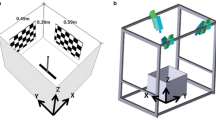Abstract
The landing response of tethered flying housefliesMusca domestica elicited by motion of periodic gratings is analysed. The field of view of the compound eyes of a fly can be subdivided into a region of binocular overlap and a monocular region. In the monocular region the landing response is elicited by motion from front to back and suppressed by motion from back to front. The sensitivity to front to back motion in monocular flies (one eye covered with black paint) has a maximum at an angle 60°–80° laterally from the direction of flight in the equatorial plane. The maximum of the landing response to front to back motion as a function of the contrast frequencyw/λ is observed at around 8 Hz. In the region of binocular overlap of monocular flies the landing response can be elicited by back to front motion around the equatorial plane if a laterally positioned pattern is simulataneously moved from front to back. 40° above the equatorial plane in the binocular region the landing response in binocular flies is elicited by upward motion, 40° below the equatorial plane in the binocular region it is elicited by downward motion. The results are interpreted as an adaptation of the visual system of the fly to the perception of a flow field having its pole in the direction of flight.
Similar content being viewed by others
References
Beersma, D.G.M., Stavenga, D.G., Kuiper, J.W.: Retinal lattice, visual field and binocularities in flies. Dependence on species and sex. J. Comp. Physiol.119, 207–220 (1977)
Braitenberg, V., Taddei-Ferretti, C.: Landing reaction ofMusca domestica induced by visual stimuli. Naturwissenschaften53, 135–156 (1966)
Braitenberg, V.: Ordnung und Orientierung der Elemente im Sehsystem der Fliege. Kybernetik7, 235–242 (1970)
Collett, T.S.: Some operating rules for the optomotor system of a hoverfly during voluntary flight. J. Comp. Physiol.138, 271–282 (1980)
Eckert, H.: Optomotorische Untersuchungen am visuellen System der StubenfliegeMusca domestica L. Kybernetik14, 1–23 (1973)
Eckert, H.: Anatomie, Elektrophysiologie und funktionelle Bedeutung bewegungssensitiver Neurone in der Sehbahn von Dipteren. Habilitationsschrift, Ruhr-Universität Bochum (1979a)
Eckert, H.: Orientation sensitivity of the visual movement detection system activating the landing response of the blowflies,Calliphora andPhaenicia: A behavioural investigation. Biol. Cybern.37, 235–247 (1980)
Eckert, H., Fligge, B., Hamdorf, K.: Excitation and inhibition of the landing response of the blowfly,Calliphora. Naturwissenschaften66, 368 (1979)
Eckert, H., Hamdorf, K.: Excitatory and inhibitory response components in the landing response of the blowfly,Calliphora erythrocephala. J. Comp. Physiol.138, 253–246 (1980)
Fermi, G., Reichardt, W.: Optomotorische Reaktionen der FliegeMusca domestica. Abhängigkeit der Reaktion von der Wellenlänge, der Geschwindigkeit, dem Kontrast und der mittleren Leuchtdichte bewegter periodischer Muster. Kybernetik2, 15–28 (1963)
Franceschini, N., Kirschfeld, K.: Etude optique in vivo des elements photorecepteurs dans l'oeil compose de Drosophila. Kybernetik8, 1–13 (1971)
Götz, K.G.: Flight control in, Drosophila by visual perceptional of motion. Kybernetik4, 199–208 (1968)
Goodman, Lesley, J.: The landing responses of insects. I. The landing J. exp. Biol.37, 854–878 (1960)
Hausen, K.: Struktur, Funktion und Konnektivität bewegungsempfindlicher Interneurone im dritten optischen Neuropil der SchmeißfliegeCalliphora erythrocephala. Dissertation, Eberhard-Karls-Universität Tübingen, 1976a
Hausen, K.: Functional characterization and anatomical identification of motion sensitive neurons in the lobula plate of the blowflyCalliphora erythrocephala. Z. Naturforsch.31c, 629–233 (1976b)
Pick, B.: Visual pattern discrimination as an element of the fly's orientation behaviour. Biol. Cybern.23, 171–180 (1976)
Reichardt, W.: Musterinduzierte Flugorientierung. Verhaltens-Versuche an der FliegeMusca domestica. Naturwissenschaften60, 122–138 (1973)
Reichardt, W., Poggio, T.: Visual control of orientation behaviour in the fly. I. A. quantitative analysis. Quart. Rev. Biophys.9, 311–375 (1973)
Taddei-Ferretti, C., Fernandez Perez de Talens, A.: La reazione datteraggio dellaMusca domestica. Atti Conregno Gruppo Nazionale Cibernetica, Pisa, pp. 24–31 (1967)
Taddei-Ferretti, C., Fernandez Perez de Talens, A.: Neurosistemi: Esperimenti sulla reazione datteraggio dellaMusca domestica. Atti I Congresso Nazionale Cibernetica, Casciana, Terme, pp. 268–278 (1971)
Taddei-Ferretti, C., Fernandez Perez de Talens, A.: Conditions for an object moving in a flys visual field to be stimulating for landing. Atti II Congresso Nazionale Cibernetica, Casciana Terme, pp. 203–212 (1972) Taddei-Ferretti, C., Fernandez perez de Talens, A.: Landing reaction ofMusca domestica. IV. A. Monocular and binocular vision; B. Relationships between landing and optomotor reactions. Z. Naturforsch.28c, 579–592 (1973)
Varju, D., Reichardt, W.: Übertragungseigenschaften im Auswertesystem für das Bewegungssehen. II. Z. Naturforsch.22b, 1343–1351 (1967)
Wagner, H.: messung und Beschreibung von Landetrajektorien der Stubenfliege (Musca d.). Diplomarbeit, Eberhard-Karls-Universität, Tübingen 1980
Wehrhahn C.: Flight torque and lift responses of the housefly (Musca domestica) to a single stripe moving in different parts of the visual field. Biol. Cybern.29, 237–247 (1978a)
Wehrhahn, C.: The angular orientation of the movement detectors acting on the flight lift response in flies. Biol. Cybern.31, 169–173 (1978b)
Wehrhahn, C.: Visual fixation and tracking in flies. In: Mathematical models in molecular and cellular biology. Segel, L.A. (ed.) Cambridge: Cambridge University Press 1980
Wehrhahn, C., Hausen, K.: How is tracking and fixation accomplished in the nervous system of the fly? A behavioural analysis based on short time stimulation. Biol. Cybern.38, 179–187 (1980)
Author information
Authors and Affiliations
Rights and permissions
About this article
Cite this article
Wehrhahn, C., Hausen, K. & Zanker, J. Is the landing response of the housefly (Musca) driven by motion of a flow field?. Biol. Cybern. 41, 91–99 (1981). https://doi.org/10.1007/BF00335364
Received:
Issue Date:
DOI: https://doi.org/10.1007/BF00335364




